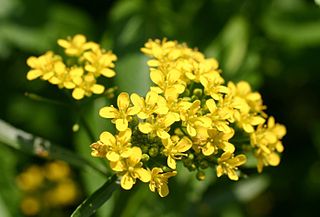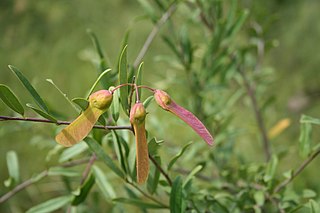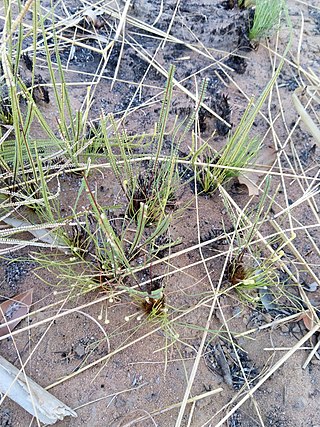
Lygodium is a genus of about 40 species of ferns, native to tropical regions across the world, with a few temperate species in eastern Asia and eastern North America. It is the sole genus in the family Lygodiaceae in the Pteridophyte Phylogeny Group classification of 2016. Alternatively, the genus may be placed as the only genus in the subfamily Lygodioideae of a more broadly defined family Schizaeaceae, the family placement used in Plants of the World Online as of November 2019. Per recent molecular evidence, Lygodiaceae is thought to have diverged relatively early from the other members of the Schizaeales due to the relatively high level of synonymous sequence divergence between the families within the Schizaeales.

Nasturtium is a genus of a small number of plant species in the family Brassicaceae commonly known as watercress or yellowcress. The best known species are the edible Nasturtium officinale and Nasturtium microphyllum. Nasturtium was previously synonymised with Rorippa, but molecular evidence supports its maintenance as a distinct genus more closely related to Cardamine than to Rorippasensu stricto.

Rorippa is a genus of flowering plants in the family Brassicaceae, native to Europe through central Asia, Africa, and North America. Rorippa species are annual to perennial herbs, usually with yellow flowers and a peppery flavour. They are known commonly as yellowcresses.

The Polygalaceae or the milkwort family are made up of flowering plants in the order Fabales. They have a near-cosmopolitan range, with about 27 genera and ca. 900 known species of herbs, shrubs and trees. Over half of the species are in one genus, Polygala, the milkworts.

Parkinsonia microphylla, the yellow paloverde, foothill paloverde or little-leaved palo verde; syn. Cercidium microphyllum), is a species of palo verde.

Balaustion is a monotypic genus of flowering plants in the myrtle family, Myrtaceae. The sole species is Balaustion pulcherrimum, commonly known as the native pomegranate, which is endemic to Western Australia.

The greater mouse-tailed bat is a species of bat in the Rhinopomatidae family.

Lygodium microphyllum is a climbing fern originating in tropical Africa, Southeast Asia, Melanesia and Australia. It is an invasive weed in Florida where it invades open forest and wetland areas. The type specimen was collected in the vicinity of Nabúa, on the island of Luzon in the Philippines by Luis Née.
Syzygium microphyllum is a species of plant in the family Myrtaceae. It is endemic to India. It is threatened by habitat loss. In 1998 the now disputed taxon Syzygium gambleanum was listed as extinct in the IUCN Red List. However, after research work by the Royal Botanic Gardens Kew this plant was revealed as identical with Syzygium microphyllum and so the name Syzygium gambleanum became an illegitimate synonym.
Tetrorchidium microphyllum is a species of plant in the family Euphorbiaceae. It is endemic to Panama. It is threatened by habitat loss.
Leontopodium microphyllum, known as Taiwan edelweiss, or small leaf edelweiss, is a species of plant in the family Asteraceae. It is endemic to the mountains of Taiwan.

Epidendrum microphyllum is a species of tropical orchid in the genus Epidendrum with non-resupinate flowers.

Pteris platyzomopsis, synonym Platyzoma microphyllum, is a species of fern in the family Pteridaceae. When placed in the genus Platyzoma, it was the only species; the genus was sometimes placed in its own family, Platyzomaceae. The species is native to northern Australia, occurring in the Kimberley region of Western Australia, in the Northern Territory and Queensland, and in northern New South Wales, where it is considered endangered. Vernacular names include braid fern.

Tanacetum microphyllum is a species of flowering plant in the aster family, Asteraceae. It is endemic to the Iberian Peninsula.
T. microphyllum may refer to:
Palaquium microphyllum is a tree in the family Sapotaceae. The specific epithet microphyllum means "small leaves".

Nasturtium microphyllum, the onerow yellowcress, is an aquatic plant species widespread across Europe and Asia, and naturalized in the United States, Canada, Mexico, Central America, Australia, New Zealand and other places. It occurs in wet locations generally at elevations less than 1500 m. It has been reported from every Canadian province except Nova Scotia and Saskatchewan. In the US, it is fairly common in New England, New York, and Michigan, with scattered populations in the southern and western parts of the country.
Neomusotima conspurcatalis is a moth in the family Crambidae. It was described by William Warren in 1896. It is found in India, Indonesia, East Timor and Australia.

Leionema microphyllum, commonly known as limestone phebalium, is a small shrub with terminal clusters of white-pink flowers in spring. It is a rare plant in Victoria and South Australia.












